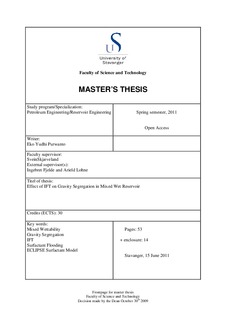| dc.contributor.author | Purwanto, Eko | |
| dc.date.accessioned | 2011-10-28T14:38:26Z | |
| dc.date.available | 2011-10-28T14:38:26Z | |
| dc.date.issued | 2011 | |
| dc.identifier.uri | http://hdl.handle.net/11250/183390 | |
| dc.description | Master's thesis in Petroleum engineering | no_NO |
| dc.description.abstract | The effects of water-oil interfacial tension (IFT) on gravity segregation and its implication on oil recovery have been investigated by numerical simulations and steady state upscaling. Eclipse surfactant model was used to introduce the reduction of IFT. Micro-scale mechanisms of the surfactant model, such as relative permeability alteration and residual oil saturation (Sor) reduction, were turned off in order to isolate the effect of IFT on gravity segregation mechanism.
Oil recovery in the system with gravity segregation was found to be higher than the oil recovery given by the system without gravity segregation. Gravity segregation behind the displacement front caused the oil phase to move upwards and eventually accumulated at the top of the model, thus increasing the effective horizontal oil mobility. Capillary forces will act against this segregation. A reduction in IFT will decrease the capillary forces, thus increasing magnitude of the segregation.
The degree of gravity segregation was also found to increase with increasing water-oil density difference, increasing model thickness, and increasing horizontal permeability. A correlation between the degree of gravity segregation and dimensionless Bond number (NB) which combines all of those parameters was established. If the NB is plotted against the Sor, the shape of the curve would resemble the Capillary Desaturation Curve (CDC) in which there is a critical value where the Sor starts to decrease.
Gravity segregation is a slow process. Low injection velocity must be applied in order to give sufficient time for the gravity forces to act in the system. There is a critical velocity above which gravity segregation will not be observed. This critical velocity was found to increase with increasing vertical permeability, increasing oil-water density difference, and decreasing the model thickness. All of the pertinent parameters were then combined in the form of dimensionless viscous-gravity ratio (Rvg). It was found that gravity segregation will start to occur when the Rvg equals to one. | no_NO |
| dc.description.sponsorship | International Research Institute of Stavanger (IRIS) | no_NO |
| dc.language.iso | eng | no_NO |
| dc.publisher | University of Stavanger, Norway | no_NO |
| dc.relation.ispartofseries | Masteroppgave/UIS-TN-IPT/2011; | |
| dc.subject | petroleumsteknologi | no_NO |
| dc.subject | reservoarteknologi | no_NO |
| dc.subject | wettability | no_NO |
| dc.subject | gravitysegregation | no_NO |
| dc.subject | IFT | no_NO |
| dc.subject | surfactantflooding | no_NO |
| dc.subject | eclipsesurfactantmodel | no_NO |
| dc.title | Effect of IFT on gravity segregation in mixed wet reservoir | no_NO |
| dc.type | Master thesis | no_NO |
| dc.subject.nsi | VDP::Technology: 500::Rock and petroleum disciplines: 510::Petroleum engineering: 512 | no_NO |
